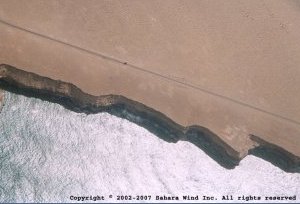 Saharan Atlantic shores are desert and dry, exposed to high solar radiation. The lack of water limits vegetation growth, making human presence relying on traditional agriculture or grazing hardly sustainable.
Saharan Atlantic shores are desert and dry, exposed to high solar radiation. The lack of water limits vegetation growth, making human presence relying on traditional agriculture or grazing hardly sustainable.
High temperature differences and a lengthy erosion process altered the region's geomorphology into plateaus of bare rock surfaces. Shaped by winds, they are locally referred to as ‘Hamadas’.
Sand dunes present in our imagination make up only about 5 % of the entire surface of the Sahara desert.
Where the Atlantic Ocean meets with the Sahara, a global energy exchange zone is created. Dominated by steady winds spreading inland, the 2000 kilometers’ coastline from Morocco to Senegal has one of the planet’s largest on-shore wind potential.
Harsh climate conditions limits population densities to 1 hab./1000 km2, concentrated around water holes. Continuously expanding, they constitute today’s local urban hubs for communities.



